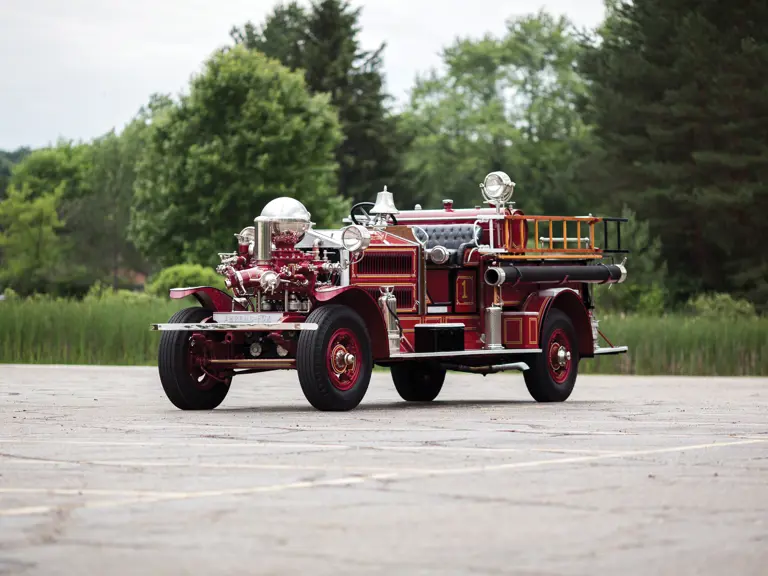 | Auburn, Indiana
| Auburn, Indiana

1924 Ahrens-Fox N-S-4
{{lr.item.text}}
$82,500 USD | Sold
{{bidding.lot.reserveStatusFormatted}}
- Large displacement inline six-cylinder
- "Rolls-Royce of fire trucks"
- Total 2006 frame-off restoration
- Completed by Delong Fire Equipment in Ohio
- "N" designation said to equal 1,000-gpm pumper
- Easily recognizable design
- Air-equalization chamber at front
- Considered as work of art and very capable
- Long time manufacturer of fire equipment
- Meticulously presented
Ahrens-Fox has long held great respect amongst firefighting apparatus manufacturers and have long been considered the “Rolls-Royce of Fire Trucks.” They fall into the enviable position of rolling works of art and remarkably capable. This was the best equipment to have for the firehouse and as such, the Ahrens-Fox brand has become the envy of collectors worldwide.
The reliability, quality and performance of Ahrens-Fox fire gear is no more vividly demonstrated that by the preservation of the Ahrens-Fox brand into current times on fire apparatus built by HME Corporation, who themselves was founded in 1913.
Fire equipment gets, hopefully, little use but needs to be at its best on a moment’s notice and function reliably for hours, even days, on end. It was in this context that Ahrens-Fox’s reputation was built. The company traces its history to the beginnings of the steam fire engine era when Alexander B. Latta built his first steam-powered fire engine in Cincinnati in 1852. Chris Ahrens was an apprentice in Latta’s firm and eventually assumed ownership, later merging with American LaFrance in 1903. Ahrens’ son-in-law Charles Fox along with Ahrens’ sons and another son-in-law parted company with the combined firm a year later to start another company which became Ahrens-Fox in 1910. While still building a few horse-drawn steam fire engines Ahrens-Fox also built the apparatus powered by Walter Christie’s pioneering two-wheel tractors, then concentrated on four-wheel gasoline motor-driven units.
Its pumpers are instantly identified by the giant chrome sphere pressure-equalizer above the front-mounted multi-piston pumps on which Ahrens-Fox’s pumpers’ reputations were grounded. Ahrens-Fox proudly pointed out that it built nearly everything on its fire apparatus in its Cincinnati factory, even the giant engines under the long hoods. The pumping power of an Ahrens-Fox is legendary, and they are immediately recognizable.
One of the features that help in identifying a vehicle and gives it a unique presence to the frontal beauty of a car is its grille. The fantastic and renowned Ahrens-Fox piston pumper has a grille, all right, but that's not what really attracts your attention to the business end of this brutish rig. Instead, it's the massive, upright pump with all its polished fittings that presents the Ahrens-Fox serious nature, and helps to secure its place in history as having one of the most remarkable “faces” in the world of motor vehicles.
Its fabulous visage, usually framed by a pair of huge headlamps, is the vertical pump, which was first topped by a single air-equalization chamber on the Model K, appearing first in 1915, and became the standard of Ahrens-Fox for the next 37 years. The pump has a pair of vertically moving pistons, and the air chamber keeps the pressure constant during their reciprocations, ensuring that the engine's main stream of water is steady while being directed at the flames, not pulsating like a Super Soaker. Earlier motorized Ahrens-Fox piston pumpers actually used a pair of cylindrical chambers atop the pump, but the Model K was the first to use the single, balloon-shaped air chamber.
This Model “N” runs with a large displacement inline six-cylinder engine, also the “N” designation equates to the fire truck having a 1,000 gallon per minute (gpm) pumper. It is reported this truck has a “quad pump” and has received a total frame-off restoration in 2006 by Delong Fire Equipment in Medina, Ohio. The letter “S” indicated shaft-drive and the N-S-4 employed a booster-tank system. It is stated that all systems have been gone through, including the rebuilding of the engine, transmission and rear end. All plating is nickel and there is also a great amount of polished brass. Wooden ladders, aluminum foot plates, large steel wheels, spotlights, bell, button-tufted upholstery, hoses, beautiful pinstriping and additional period fittings complete this outstandingly presented N-S-4 Ahrens-Fox.
While Ahrens-Fox also produced ladder trucks and comparatively conventional rigs with rotary water pumps, it was the vertical, dual-suction piston pumps that presented the company with its "fighting face" of lore. Meticulously restored, it will earn pride of place at any display. It runs and drives superbly, and still pumps towers of water.




